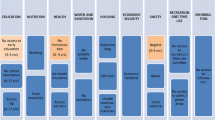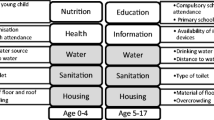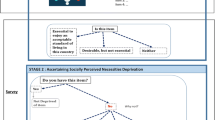Abstract
Child poverty is a global concern which is usually not captured for monetary measures. Therefore, multidimensional approaches to measure child poverty have increased in the past decade. However, there is still no consensus about what constitutes multidimensional child poverty, how it should be measured, and which criteria should be adopted to identify poor children in a society. We discuss the opinions of experts in order to inform the methodological decision-making processes in multidimensional poverty measurement. We conducted thematic analysis of semi-structured interviews with 27 global experts on child poverty and poverty measurement. We contrasted the degree of agreement and reasons to include dimensions and indicators in a multidimensional child-poverty measure for low- and middle-income countries. We found agreement and disagreement about the inclusion of multiple dimensions and indicators. On the one hand, Education, Nutrition, Water and Sanitation, Access to Health Care, and Immunisation were the indicators with the highest levels of agreement. On the other hand, Safety, Child Labour, Access to Information, and Cultural Activities were the group of indicators producing less agreement between experts. We found that debates regarding decisions in the process of designing a multidimensional child-poverty measure were related to the theoretical perspectives on child poverty, the rationale of the indicators, the data available, and technical issues. In conclusion, methodological decisions about the selection of dimensions and indicators to measure multidimensional child poverty requires a critical reflection on the perspectives of poverty that the researchers use, the objective of the measure, the data available, and how deprivations can be operationalised.

Similar content being viewed by others
Data Availability
The datasets used and analysed during the current study are available from the corresponding author on reasonable request.
Code Availability
The NVivo files are available from the corresponding author on reasonable request.
References
Alkire, S. (2018) The research agenda on multidimensional poverty measurement: important and as-yet unanswered questions. OPHI Working Paper 119, University of Oxford
Alkire, S., Foster, J., Seth, S., Santos, M. E., Roche, J. M., & Ballon, P. (2015). Multidimensional poverty measurement and analysis. Oxford University Press.
Alkire, S., Lham, D., Gyeltshen, S. & Minten, T. (2016) Child Poverty in Bhutan: Insights from Multidimensional Child Poverty Index and Qualitative Interviews with Poor Children.Thumphu, Bhutan
Biggeri, M., Ballet, J., & Comim, F. (Eds.). (2011). Children and the capability approach. Palgrave Macmillan.
Biggeri, M., & Cuesta, J. A. (2021). An Integrated Framework for Child Poverty and Well-Being Measurement: Reconciling Theories. Child Indicators Research, 14(2), 821–846.
Biggeri, M., Libanora, R., Mariani, S., & Menchini, L. (2006). Children Conceptualizing their Capabilities: Results of a Survey Conducted during the First Children’s World Congress on Child Labour. Journal of Human Development, 7(1), 59–83.
Biggeri, M., Trani, J.-F. & Mauro, V. (2010 ) The multidimensionality of child poverty: An empirical investigation on children in Afghanistan.Florence.
Braun, V., & Clarke, V. (2006). Using thematic analysis in psychology. Qualitative Research in Psychology, 3(2), 77–101.
Chzhen, Y., Gordon, D. & Handa, S. (2017) Measuring Multidimensional Child Poverty in the Era of the Sustainable Development Goals. Child Indicators Research.
Colacce, M. & Tenenbaum, V. (2006) Pobrea y Privaciones Múltiples En La Infancia En Uruguay. Montevideo.
Cuesta, J., Biggeri, M., Hernandez-Licona, G., Aparicio, R., & Guillén-Fernández, Y. (2020). The political economy of multidimensional child poverty measurement: A comparative analysis of Mexico and Uganda. Oxford Development Studies, 48(2), 117–134.
Datta, S. & Kingdon, G. G. (2019) Gender Bias in Intra-Household Allocation of Education in India: Has It Fallen over Time? Discussion paper series IZA DP No. 12671.
De Neubourg, C., Chai, J., Milliano, M. d. & Plavgo, I. (2012) Step-by-Step Guidelines to the Multiple Overlapping Deprivation Analysis (MODA)’, Working Paper 2012–10. Florencia UNICEF Office of Research.
De Neubourg, C., Chai, J., Milliano, M. d. & Plavgo, I. (2013) Cross-Country MODA Study: Multiple Overlapping Deprivation Analysis (MODA). Technical Note WP-2012–05. Florence UNICEF Office of Research.
Delamonica, E. (2014). Separating and combining child and adult poverty: Why? How? CROP Poverty Brief 15. Bergen.
Espíndola, E., Sunkel, G., Murden, A. & Milosavljevic, V. (2017) Medición multidimensional de la pobreza infantil. Una revisión de sus principales componentes teóricos, metodológicos y estadísticos.Santiago de Chile, Chile.
EUROSTAT (2012) Measuring material deprivation in the EU. Indicators for the whole population and child-specific indicators.Luxemburg.
Frediani, A. A. (2015) ‘Participatory Capabilities’ in Development Practice, in Frediani, A. A. & Hansen, J. (eds), The Capability Approach in Development Planning and Urban Design. DPU Working Papers Special Issue. London: UCL.
García, S., & Ritterbusch, A. (2015). Child Poverty in Colombia: Construction of a Multidimensional Measure Using a Mixed-Method Approach. Child Indicators Research, 8(4), 801–823.
Glesne, C. (2016). Becoming Qualitative Researchers: An Introduction. Person.
Gordon, D., Nandy, S., Pantazis, C., Pemberton, S. & Townsend, P. (2003) Child poverty in the developing world. Bristol The policy press.
Inter-Agency and Expert Group on Sustainable Development Goal Indicators (2016) Final list of proposed Sustainable Development Goal indicators 2016. Available online: https://sustainabledevelopment.un.org/content/documents/11803Official-List-of-Proposed-SDG-Indicators.pdf [Accessed.
Klasen, S. & Lahoti, R. (2021) How Serious is the Neglect of Intra-Household Inequality in Multidimensional Poverty and Inequality Analyses? Evidence from India. Review of Income and Wealth.
Lansdown, G. (2011) Every child’s right to be heard a resource guide on the un committee on the rights of the child general comment no.12. London: Save the Children UK.
Leu, C.-H., Chen, K.-M., & Chen, H.-H. (2016). A multidimensional approach to child poverty in Taiwan. Children and Youth Services Review, 66, 35–44.
Minujin, A., Delamonica, E., Davidziuk, A., & Gonzalez, E. D. (2006). The definition of child poverty: A discussion of concepts and measurements. Environment and Urbanization, 18(2), 481–500.
Minujin, A., Delamonica, E., Gonzalez, E. D. & Davidziuk, A. (2005) Childen living in poverty. A review of child poverty definitions, measurements, and policies, Unicef conference children and poverty: Global context, local solutions. New School University: New York Unicef.
O’Hare, W. P., & Gutierrez, F. (2012). The Use of Domains in Constructing a Comprehensive Composite Index of Child Well-Being. Child Indicators Research, 5(4), 609–629.
Pinilla-Roncancio, M., García-Jaramillo, S., Carrero, A. L., González-Uribe, C. & Ritterbusch, A. (2020) Child vs. Household MPIs in Colombia: Do they Identify the Same Children as Multidimensionally Poor? Child Indicators Research, 13(3), 777–799.
Qi, D. & Wu, Y. (2018) Comparing the Extent and Levels of Child Poverty by the Income and Multidimensional Deprivation Approach in China. Child Indicators Research.
Roelen, K. (2017). Monetary and Multidimensional Child Poverty: A Contradiction in Terms? Development and Change, 48(3), 502–533.
Roelen, K. (2018). Poor Children in Rich Households and Vice Versa: A Blurred Picture or Hidden Realities? The European Journal of Development Research, 30(2), 320–341.
Roelen, K., & Camfield, L. (2013). A Mixed-Method Taxonomy of Child Poverty – the Case of Ethiopia. Applied Research in Quality of Life, 8(3), 319–337.
Roelen, K. & Gassmann, F. (2008) Measuring child poverty and well-being: a literature review. Munich Personal RePEc Archive, MGSoG/2008/WP001.
Roelen, K., Gassmann, F., & de Neubourg, C. (2009). The Importance of Choice and Definition for the Measurement of Child Poverty—the case of Vietnam. Child Indicators Research, 2(3), 245–263.
Saldana, J. (2012) The Coding Manual for Qualitative ResearchersSAGE Publications.
Save the Children (2016) Child Poverty. What drives it and what it means to children across the world.London.
Sen, A. (1979) Equality of what? The Tanner Lecture on Human Values. , delivered at Stanford University, May 22, 1979 in (Ed.), S. M. (ed), Tanner Lectures on Human Values (Vol. 1). Cambridge, UK: Cambridge University Press.
Sen, A. (1999). Development as freedom. Oxford University Press.
Silwal, A. R., Engilbertsdottir, S., Cuesta, J., Newhouse, D. & Stewart, D. (2020) Global Estimate of Children in Monetary Poverty: An Update.Washington.
Trani, J.-F., Biggeri, M., & Vincenzo, M. (2013). The Multidimensionality of Child Poverty: Evidence from Afghanistan. Social Indicators Research, 112(2), 391–416.
Trani, J.-F., & Cannings, T. (2013). Child Poverty in an Emergency and Conflict Context: A Multidimensional Profile and an Identification of the Poorest Children in Western Darfur. World Development, 48, 48–70.
UNICEF (2017) A world free from child poverty. A guide to the tasks to achieve the vision. New York: UNICEF.
United Nations Human Rights Office of the High Commissioner (1989) Convention on the Rights of the Child. Geneva OHCHR.
United Nations Children’s Fund (UNICEF). (2005). The State of the World’s Children 2005: Childhood Under Threat. UNICEF.
United Nations Development Programme (UNDP) & Oxford Poverty and Human Development Initiative (OPHI). (2020). Global Multidimensional Poverty index 2020 – Charting Pathways out of Multidimensional Poverty: Achieving the SDGs. Report.
Vijaya, R. M., Lahoti, R., & Swaminathan, H. (2014). Moving from the Household to the Individual: Multidimensional Poverty Analysis. World Development, 59, 70–81.
World Bank. (2017). Monitoring global poverty. Report on the comission of global poverty.
Yousefzadeh, S., Biggeri, M., Arciprete, C. & Haisma, H. (2018) A Capability Approach to Child Growth. Child Indicators Research.
Author information
Authors and Affiliations
Corresponding author
Ethics declarations
Ethical Approval
The study was approved by the Research Ethics Committee at the University of Los Andes on November 28 of 2016 (file 678 de 2016).
Consent to Participate
Informed consent was obtained from all individual participants included in the study.
Conflict of Interest
We confirm that there is no potential conflict of interest.
Additional information
Publisher's Note
Springer Nature remains neutral with regard to jurisdictional claims in published maps and institutional affiliations.
Supplementary Information
Below is the link to the electronic supplementary material.
Rights and permissions
About this article
Cite this article
Pinilla-Roncancio, M., Ritterbusch, A.E., Sanchez-Franco, S. et al. Conceptual Debates on Poverty Measurement: The Use of Qualitative Expert Consultation to Guide Methodological Decision-making in Designing a Multidimensional Child-Poverty Measure. Child Ind Res 14, 2449–2469 (2021). https://doi.org/10.1007/s12187-021-09852-x
Accepted:
Published:
Issue Date:
DOI: https://doi.org/10.1007/s12187-021-09852-x




